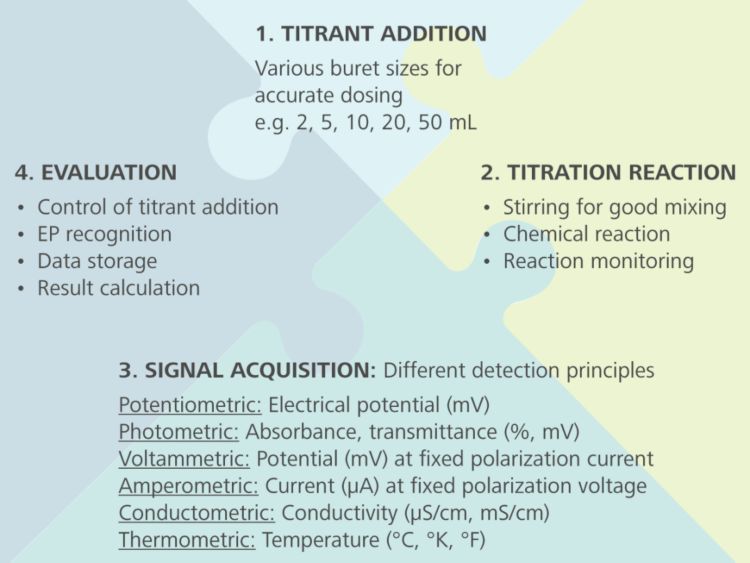If you are in the pharmaceutical industry and wonder if a conversion from a manual titration to an automated titration is suitable for your work, this blog post should give you all the answers you need.
I will cover the following topics in this article (click to go directly to each one):
Applicability of modern titration methods in pharmaceutical analysis
Perhaps you have already heard or read about automated titration and its benefits in comparison to manual titration, but are now wondering whether those guidelines are also applicable to pharmaceutical analysis.
Getting straight to the point: Yes, it is true that many USP monographs as well as USP General Chapter <541> Titrimetry still refer to the manual visual endpoint titration. But there’s good news! USP-NF General Notices and Requirements Section 6.30 states:
As long as the alternative method is fully validated and you can prove that both methods are equivalent, you are allowed to use alternative methods.
Since titration still plays an important role in pharmaceutical analytical procedures and processes, Metrohm offers a variety of applications for innumerous API monographs of the United States Pharmacopeia as well as pharmacopeia-compliant analytical instruments.
Automated titration procedure
Have you wondered about how to perform the procedure of an automated titration—how does it differ from a manual titration? Working with a pharmacopeia compliant analytical instrument from Metrohm is not so different:
- Titrant is added with an automated piston buret that safely controls the delivery of titrant to a precise level.
- The sample is homogenized with a stirrer.
- The electrode detects the titration endpoint, removing subjectivity of color changes.
- Results are automatically calculated and displayed allowing no room for human error.

As shown in Figure 1, an automated titration procedure mainly consists of four steps. These steps are repeated until the end of the titration (Figure 2).
In addition, all Metrohm devices that run with proprietary tiamo® or OMNIS® software are 21 CFR Part 11 compliant meeting all ALCOA+ requirements. Thanks to improvements in productivity, accuracy, and precision, the human influence on analysis is reduced to a minimum.
If you are wondering how to transfer a manual titration to automated titration, then check out our earlier blog posts on this topic. Also, download our free White Paper comparing manual and automated titration.
How to Transfer Manual Titration to Autotitration
White Paper: Manual vs. Automated Titration: Benefits and Advantages to Switching
Choice of electrodes for pharmaceutical titrations
For autotitration, either an electrode or a photometric sensor is used to detect the point of a sample analyte neutralization. Metrohm offers a wide range of different electrodes for titrations that are extremely suitable for various pharmaceutical applications. The electrode choice depends on the type of reaction, the sample, and the titrant used. Download our free flyer here to learn more.
Electrodes for titrations - Which electrode for which application?
If you want to know more about how endpoints are recognized using electrodes or photometric sensors, read our previous blog post to find out how the endpoint is determined during an autotitration.
Maybe you are not quite sure which is the best electrode for your application. Therefore, Table 1 shows an interactive electrode guide for different pharmaceutical titrations.
| Type of titration | Electrode | Close-up view |
Pharma Application / API |
Aqueous acid/base titrations e.g., titrant is NaOH or HCl phenolphthalein indicator |
Combined pH electrode with reference electrolyte c(KCl) = 3 mol/L e.g., Ecotrode Plus, Unitrode |
 |
Water-soluble acidic and basic active pharmaceutical ingredients (API) and excipients API: Benzbromaron, Potassium carbonate, Potassium bicarbonate |
Non-aqueous acid/base titrations e.g., solvent is organic or glacial acetic acid crystal violet indicator |
Combined pH electrode with alcoholic reference electrolyte LiCl in EtOH e.g., Solvotrode easyClean |
 |
Water-insoluble weak acids and bases Assay of API API: Caffeine, Ketoconazole |
Redox titrations e.g., titrant is sodium thiosulfate starch indicator |
Pt metal electrode |
 |
Antibiotic assays Peroxide value in fats and oils API: Captropril, Paracetamol, Sulfonamide |
Precipitation titrations e.g., titrant is silver nitrate ferric ammonium sulfate indicator |
Ag metal electrode |
 |
Chloride content in pharmaceutical products Iodide in oral solutions API: Dimenhydrinate |
Complexometric titrations e.g., titrant is EDTA hydroxy naphthol blue indicator |
Ion-selective electrode e.g., combined calcium-selective electrode with polymer membrane |
 |
Calcium content in pharmaceutical products API: Calcium succinate |
Photometric titration e.g., titrant is EDTA Eriochrome black T indicator |
Photometric sensor e.g., Optrode |
 |
Assay of various metal salts in APIs |
To help you select the best electrode for your titrations, we have prepared a poster for you to easily find the perfect electrode for USP monographs. Additionally, you will find information about proper sensor maintenance and storage.
Poster: Electrodes for USP monographs
If you prefer, the Metrohm Electrode Finder is even easier to use. Select the reaction type and application area of your titration and we will present you with the best solution.
As documentation and traceability are critical for the pharmaceutical industry, Metrohm has developed fully digital electrodes, called «dTrodes». These dTrodes automatically store important sensor data, such as article number and serial number, calibration data and history, working life, and the calibration validity period on an integrated memory chip.
Conclusion
Metrohm is your qualified partner for all chemical and pharmaceutical analysis concerns and for analytical method validation.
In addition to full compliance with official directives, Metrohm instruments and applications comply with many of the quality control and product approval test methods cited in pharmacopoeias. Discover the solutions Metrohm offers the pharmaceutical industry (and you in particular!) for ensuring the quality and safety of your products.
 Partager l'article
Partager l'article
